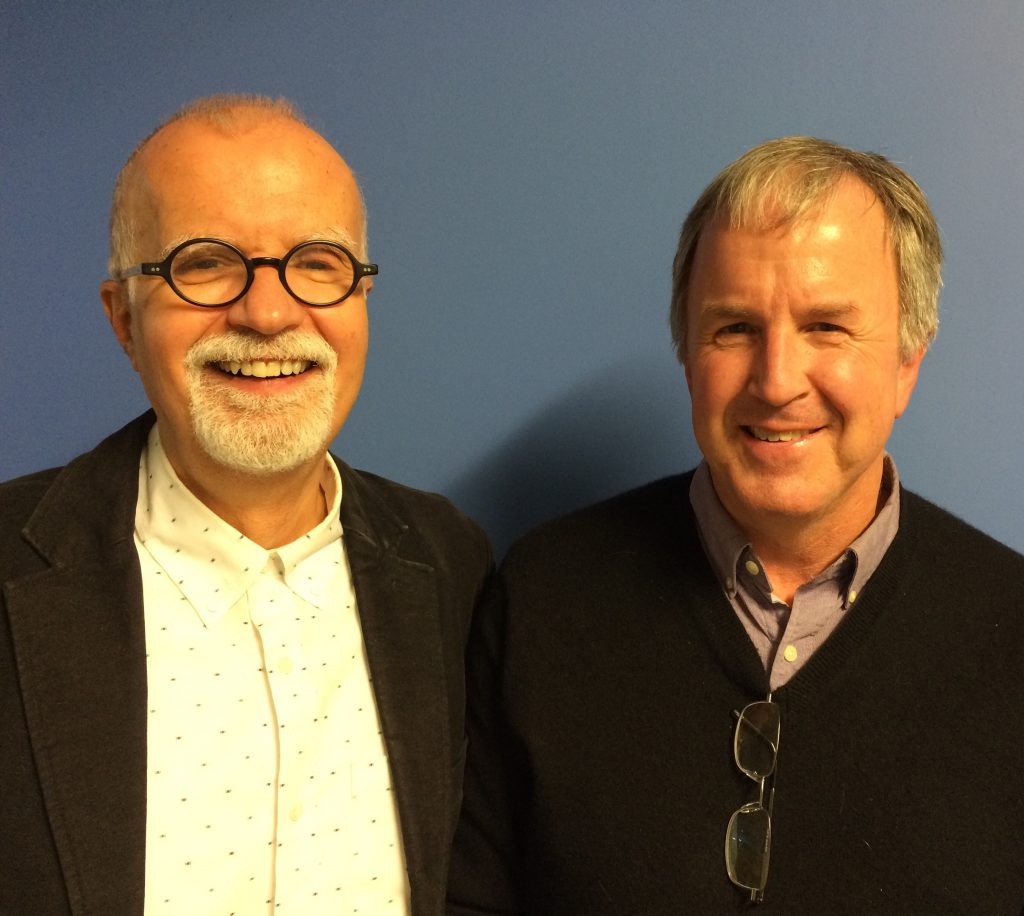by Kevin McLaughlin

“Smooth and Smart…Rodgers & Hart,” an evening of 25 songs with commentary — written, co-produced, and co-hosted by The Musical Theater Project’s Bill Rudman and the Jazz Orchestra’s Paul Ferguson — only confirmed the songs’ perfection. Rudman and Ferguson (pictured) were joined onstage by five horns from CJO, singer-pianist Joe Hunter, drummer Holbrook Riles III, bassist Aidan Plank, and vocalists Evelyn Wright and Michael Shirtz.
Rudman’s scripted commentary between musical numbers kept momentum on a smooth glide, as did film, audio clips, and slides. There was a Walter O’Keefe radio interview with Rodgers & Hart, a film short called Makers of Melody in which the two play themselves, and an excerpt from the wildly inaccurate biopic Words and Music, showing the meeting of the 16-year-old Rodgers (Tom Drake) and the 23-year-old Hart (Mickey Rooney).
Evelyn Wright sang with wisdom and pathos, and at times reached Sarah Vaughan-like majesty in songs like “Mountain Greenery,” “My Heart Stood Still,” “The Lady Is a Tramp,” “Glad to be Unhappy” and “It Never Entered My Mind.” In Pal Joey’s “Bewitched” the pitch got away from her a bit, but the song still hit its mark.
Michael Shirtz channeled the sound and spirit of Mel Tormé in gracefully crooned renditions of “This Can’t Be Love,” “Manhattan,” “Here in My Arms,” “You Have Cast Your Shadow on the Sea,” and “Wait Till You See Her.” In “The Most Beautiful Girl in the World,” some words and rhymes got a little botched, but were set right the second time through.
“The Girl Friend” was a magic trick, bringing Richard Rodgers into the room via a 1926 piano roll to accompany Shirtz. The peppy tempo — obviously authentic performance practice — would give anyone a challenge lyrically, but Shirtz managed to keep up and put across some of Hart’s wittiest lines:
My girl’s the kind of girl for steady company
It’s steady company that I prefer
When in the Charleston dance I wanta bump a knee
I wanta bump a knee with her
Stephen Sondheim has famously criticized Hart for his “lazy lyrics, mis-stressed syllables, sacrifice of meaning for rhyme,” etc. But Hart clearly loved language, and an audience responds to his playfulness and humor, whether or not rules of syntax are obeyed.
“My Heart Stood Still,” from Thou Swell (1927), was aptly paired with “A Ship Without a Sail,” from Heads Up (1929). Wright sang both songs so poignantly, it took the audience a moment to recover.
Joe Hunter sang and played the piano with elegance in “You Took Advantage of Me” and the unfamiliar “This Funny World.”
Paul Ferguson’s arranging chops served as a co-protagonist. In the marvelous “Slaughter on Tenth Avenue,” a ballet creation of George Balanchine’s from On Your Toes, just five horns managed to simulate the proportions of the original.
In “Wait till You See Her,” Ferguson mingled a single trumpet and alto sax for unusual color. In the soft ballads, judicious uses of flugelhorn and cup mute alongside open trombone were effective, not just to reduce the volume under the singer, but as distinct gradations of color. But the arranger’s finest moment may have been in the band’s layered cacophony to make the point of “I Like to Recognize the Tune.”
Rudman and Ferguson’s participation as singers in “Any Old Place with You” and “I Like to Recognize the Tune” added a sense of fun — though it wasn’t clear if Rudman’s semi-spoken performance of the latter was meant to be mimetic of the title, as Ferguson’s treatment of the score was.
Hart’s brilliance and later troubled life were brought home in several audio and film clips. Rodgers’ account of the pair’s first meeting and ensuing partnership began to make sense: “I left Hart’s house,” said Rodgers via radio broadcast, “having acquired in one afternoon a career, a partner, a best friend, and a source of permanent irritation” — owing to Hart’s erratic behavior and alcoholism. The two parted ways finally in 1943, Rodgers teaming up with Oscar Hammerstein II, and Hart dying a lonely death.
Endings are hard, and this show, perhaps like the R&H partnership itself, ended sweetly but a little flatly with “Wait Till You See Her.”
Rodgers and Hart might have wondered about a revue showcasing 25 or so of their songs, detached from dramatic contexts. But the success of the evening lay in the grace of their invention — the trying-not trying that a hundred years later sounded as smooth and smart as ever.
Published on ClevelandClassical.com February 1, 2024.
Click here for a printable copy of this article



